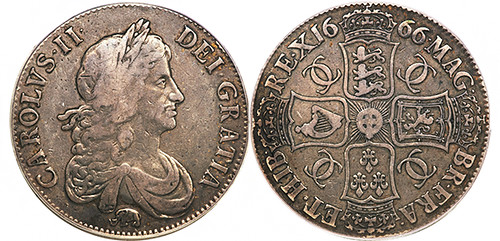
PREV ARTICLE
NEXT ARTICLE
FULL ISSUE
PREV FULL ISSUE
THE ROYAL AFRICAN COMPANY MARKOn September 3, 2014, Greg Reynolds published a
nice article in CoinWeek about the rare 1681 silver
Halfcrown of King Charles II, with the mark of the Royal African
Company. I wasn't familiar with this mark. Here's an
excerpt. Be sure to read the complete article online - it's
an interesting story. -Editor
 A relatively small number of Charles II silver coins of any denomination survive with the mark of an elephant, which relates to a semi-private company that dominated British business activities in Africa. Soon after his ascension to the throne in 1660, King Charles II granted a charter to the Company of Royal Adventurers Trading to Africa, which was renamed the Royal African Company (RAC) in 1672. This company was given a monopoly over British trade with a region in western Africa. The RAC lasted until 1752. From 1688 to 1722, the RAC supplied gold to the Royal Mint and many British coins struck from such gold featured a hallmark of an elephant. In another words, a small portrait of an elephant on a British gold coin, as part of the design, indicated that it was struck with gold that was mined in West Africa and then brought to England by the RAC. An elephant and a castle was part of the emblem of this company, and many gold coins struck in London by the Royal Mint featured an ‘elephant & castle,’ though a substantial number had just a portrait of an elephant. Each elephant mark, with or without a castle, is found below the bust on the obverse (front of the coin).
British gold coins of the era were called Guineas because much of the gold used to strike them came from West Africa. The word Guinea has more than one meaning. Undoubtedly, the British traded in the area that is now known as the Republic of Guinea, a former French colony. Over the centuries, however, the name Guinea generally referred to a particular region of West Africa, not to any one specific kingdom, nation or colony. The RAC brought gold from the region of Guinea to England and the gold denominations that began in 1663 came to be known as Guineas. Soon, gold coins were issued with denominations of Half-Guinea, One Guinea, Two Guineas and Five Guineas. Much later, One-Third-Guinea coins were minted as well. Only a miniscule percentage of silver coins of the era had elephant (or ‘elephant & castle’) marks. During the reign of Charles II, some Shillings, Halfcrowns and Crowns, dated 1666 and, later, 1681, had elephant (or ‘elephant & castle’) marks. No other silver coin issues in the 1600s had such marks, as best I can recollect at the moment. There are more than a few gold issues, though, during the reigns of James II, William III & Mary II, and Anne, that have such marks To read the complete article, see:
Wayne Homren, Editor The Numismatic Bibliomania Society is a non-profit organization promoting numismatic literature. See our web site at coinbooks.org. To submit items for publication in The E-Sylum, write to the Editor at this address: whomren@gmail.com To subscribe go to: https://my.binhost.com/lists/listinfo/esylum All Rights Reserved. NBS Home Page Contact the NBS webmaster 
|
